Handcrafted Tea cup: 130ml (4.4fl oz), diameter: 2.56inches (6.5cm) height: 3.15inches (8cm)
Sophisticated Shigaraki-Yaki
Made by Hozan Tanii
This Yunomi appears to be a simple and traditional style Japanese teacup, but it is created using elaborate techniques and is crafted from carefully selected materials passed down from generation to generation. Traditional Shigaraki glazes are made by combining three different types of glazes. However, this teacup is made using only one type of glaze known as RURIYU. It creates a unique and jewel-like beauty.
The most distinctive feature of this teacup is the glaze. RURI means lapis lazuli. This RURIYU glaze, produced by mixing an ash-laden glaze with cobalt, has been passed down from generation to generation at Hozan’s kiln. As the name suggests, this teacup’s glaze is dark blue with a hint of purple. The complex gradation of lapis lazuli color, reminiscent of deep space, is not found anywhere else among Shigaraki ceramics.
Another feature of this Yunomi is its clay. The clay, which is very rare even in the Shigaraki area of Japan, has been used for generations. The natural clay around the base has a uniquely warm and earthy color, and the HIIRO fire color is slightly seen along the border of the glaze. The fine-textured clay on the inside allows the HIIRO fire color to be seen beautifully on the bottom, contrasting wonderfully with the deep blue of the exterior. In addition to looking beautiful, fine-textured clay also mellows the taste of Japanese tea and other beverages.
HIIRO fire color is created when the Yunomi is fired in the kiln. Before firing, pure wood ash is mixed with the glaze and applied to the Yunomi. Hozan Tanii makes his special ash from oak. This ash component reacts to the iron glaze, and the fiery orange-red color is created. The unique and natural color of the clay adds a simple yet well contrasted accent to the glaze.
The smooth indentation on the lower body is called EKUBO, which means dimple in Japanese. It helps not only to create a relaxed atmosphere, but also to fit easily with the thumb when being held. There is a vertical scrape line near the EKUBO. Both line and EKUBO not only add accent to the teacup but also change the flow of the glaze.
Hozan Tanii has applied three-dimensional decorations on three places on the upper part of this Yunomi. This technique is called ICCHIN, in which clay is applied as if squeezed from a pipette to decorate the surface of the teacup. The technique requires a delicate technique that is difficult to control. The decoration alone is a testament to the time and effort that went into making this masterpiece.
This is an elaborate Yunomi, created by Hozan Tanii in partnership with nature itself. The components of the glaze, made from wood ash, and the earthenware natural clay, are heirloom materials handed down from generation to generation. Hozan Tanii controls the flow of the glaze through his many years of experience and prominent technique. This teacup will be your longtime partner, aging gracefully over time, as you enjoy each cup of Japanese green tea.
Specially packaged in a carton box.
Lead-free. Made in Japan.
(Please note that there are individual differences in each piece and each piece is unique, due to the features of this work.)






![[Limited] Snacks / Candy [Limited] Snacks / Candy](./images/seasonal_topics/Banner_Spring24.jpg)









![[Limited] SHOSOIN (handcrafted Teacup: 170ml) [Limited] SHOSOIN (handcrafted Teacup: 170ml)](/images/upload/thumbnail/SHOSOIN_A01.jpg)
![[Limited] HANA KESSHO SABI ASAGI (handcrafted Matcha Bowl) [Limited] HANA KESSHO SABI ASAGI (handcrafted Matcha Bowl)](/images/upload/thumbnail/HANAKESSHOH-SABIASAGI_A01.jpg)







